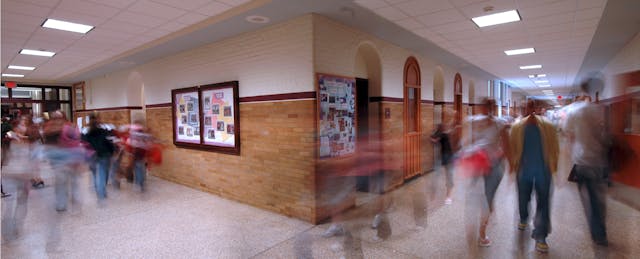School security is a constant challenge, but tragedies such as the shooting in Parkland, Fla., that killed 17 students in February bring the issue front and center. After the Parkland shooting, lawmakers from both parties saw the need for action.
The support received by the STOP School Violence Act of 2018 is an exceptional example of bipartisan agreement. The measure, which authorizes $50 million a year for increased school security technology and response training, was signed into law by President Trump in March. But it raises a key question: How should school systems spend this additional money? Beefing up physical security is just one approach. There’s also students’ health and safety to consider.
Building Consensus
A big challenge in identifying best security practices is the lack of academic research around school safety. Sometimes, the research that does exist can yield mixed results that don’t have clear policy implications.
For example, in one study, students at a school with metal detectors were less likely to carry a weapon to school (7.8 percent versus 13.6 percent). However, other studies show that increased use of metal detectors has led to students feeling less safe at school. Even perceived risk can have a negative impact on academics and mental health.
The lack of consensus around best school security practices highlights the need for continued research in this area. What methods and technologies are supported by empirical evidence that demonstrates improved safety? The STOP School Violence Act has opened up a bipartisan dialogue around school safety—and this conversation must continue in order to find solutions that actually improve our children’s safety.
One important question we need to ask is: Which security tools offer the greatest benefit for schools? To answer this question, we need to consider the frequency of different types of violence encountered in K-12 schools.
While school shootings garner the most headlines, the occurrence of gun violence in schools is very rare: On any given day, a public school student stands a roughly one in 614 million chance of being shot. Physical attacks without weapons, however, are much more frequent.
School systems should be spending the bulk of their security budgets to address the most common problems. Would a mobile panic button be a useful tool during a physical attack? Maybe. Would bulletproof whiteboards be effective? Probably not. How about staff training around how to defuse a fight before it escalates into violence?
By allocating resources to address the problems underlying physical violence, we will make our schools safer and less prone to any types of violence.
Soft Solutions to a Hard Problem
Social and emotional learning (SEL) programs that develop soft skills such as self-management, relationship skills, responsible decision making, and self-awareness are an important key to establishing the type of healthy school environment that promotes safety. Effective SEL programs provide a foundation for academic success by promoting positive student behavior and reducing emotional distress. Inclusive school environments and emotionally grounded students make for safer schools.
Where can schools start? The CASEL Guide to SEL is a useful primer. It establishes criteria for SEL curricula and reviews existing programs.
However, many of the programs it reviews are standalone programs. Although some, such as Facing History and Ourselves, touch on valuable history, social studies, and language arts standards, other programs may be valuable as extensions of the curriculum but are not likely to be incorporated into the curriculum areas holistically. That’s a problem. If an SEL program isn’t integrated seamlessly into instruction, it will likely be cast away to a semester-long health class.
Social and emotional skills are like any skills, in that students need daily practice to stay sharp. To make room in the crowded school day for this daily practice, SEL needs to be woven into the culture and curriculum of a school. Vendors are taking note: In April, Newsela—a platform that tailors news articles for classroom instruction—announced an SEL collection.
As with any subject, teachers should conduct a baseline assessment to determine what students’ needs are and tailor their instruction appropriately. This is why XSEL Labs has developed assessments for determining a student’s SEL baseline.
There are also SEL programs that harness the power of technology to provide individualized SEL instruction. Pairin, for example, uses an online survey to establish students’ strengths and areas for development. Based on students’ needs, the program can guide them through skill-specific modules.
Meeting students where they are with individualized SEL instruction makes sense, but how do we ensure they practice the skills they have learned in real life? In a high-stakes environment, will teachers find the time? And, can technology alone teach what are essentially people skills?
When I was a third-grade teacher, I put a lot of effort into improving my classroom management skills. The problem with this approach is that teachers don’t need to manage behavior, but rather model good behavior and build relationships—while giving students ownership and a voice in shaping their own behavior. By giving students the skill sets to manage their own behavior, we will create more peaceful schools and communities.


